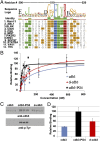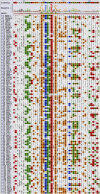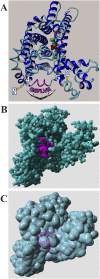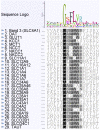Global transformation of erythrocyte properties via engagement of an SH2-like sequence in band 3
- PMID: 27856737
- PMCID: PMC5137735
- DOI: 10.1073/pnas.1611904113
Global transformation of erythrocyte properties via engagement of an SH2-like sequence in band 3
Abstract
Src homology 2 (SH2) domains are composed of weakly conserved sequences of ∼100 aa that bind phosphotyrosines in signaling proteins and thereby mediate intra- and intermolecular protein-protein interactions. In exploring the mechanism whereby tyrosine phosphorylation of the erythrocyte anion transporter, band 3, triggers membrane destabilization, vesiculation, and fragmentation, we discovered a SH2 signature motif positioned between membrane-spanning helices 4 and 5. Evidence that this exposed cytoplasmic sequence contributes to a functional SH2-like domain is provided by observations that: (i) it contains the most conserved sequence of SH2 domains, GSFLVR; (ii) it binds the tyrosine phosphorylated cytoplasmic domain of band 3 (cdb3-PO4) with Kd = 14 nM; (iii) binding of cdb3-PO4 to erythrocyte membranes is inhibited both by antibodies against the SH2 signature sequence and dephosphorylation of cdb3-PO4; (iv) label transfer experiments demonstrate the covalent transfer of photoactivatable biotin from isolated cdb3-PO4 (but not cdb3) to band 3 in erythrocyte membranes; and (v) phosphorylation-induced binding of cdb3-PO4 to the membrane-spanning domain of band 3 in intact cells causes global changes in membrane properties, including (i) displacement of a glycolytic enzyme complex from the membrane, (ii) inhibition of anion transport, and (iii) rupture of the band 3-ankyrin bridge connecting the spectrin-based cytoskeleton to the membrane. Because SH2-like motifs are not retrieved by normal homology searches for SH2 domains, but can be found in many tyrosine kinase-regulated transport proteins using modified search programs, we suggest that related cases of membrane transport proteins containing similar motifs are widespread in nature where they participate in regulation of cell properties.
Keywords: SH2 domain motif; anion exchanger 1; erythrocyte glycolysis; regulation of transport proteins; tyrosine phosphorylation.
Conflict of interest statement
The authors declare no conflict of interest.
Figures








Similar articles
-
Identification of a critical ankyrin-binding loop on the cytoplasmic domain of erythrocyte membrane band 3 by crystal structure analysis and site-directed mutagenesis.J Biol Chem. 2003 Feb 28;278(9):6879-84. doi: 10.1074/jbc.M211137200. Epub 2002 Dec 12. J Biol Chem. 2003. PMID: 12482869
-
Identification of contact sites between ankyrin and band 3 in the human erythrocyte membrane.Biochemistry. 2012 Aug 28;51(34):6838-46. doi: 10.1021/bi300693k. Epub 2012 Aug 14. Biochemistry. 2012. PMID: 22861190 Free PMC article.
-
Identification of adducin-binding residues on the cytoplasmic domain of erythrocyte membrane protein, band 3.Biochem J. 2016 Oct 1;473(19):3147-58. doi: 10.1042/BCJ20160328. Epub 2016 Jul 19. Biochem J. 2016. PMID: 27435097 Free PMC article.
-
The molecular basis for membrane - cytoskeleton association in human erythrocytes.J Cell Biochem. 1982;18(1):49-65. doi: 10.1002/jcb.1982.240180106. J Cell Biochem. 1982. PMID: 6461664 Review.
-
Band 3 anion exchanger and its involvement in erythrocyte and kidney disorders.Curr Opin Hematol. 2002 Mar;9(2):133-9. doi: 10.1097/00062752-200203000-00009. Curr Opin Hematol. 2002. PMID: 11844997 Review.
Cited by
-
Metabolite and protein shifts in mature erythrocyte under hypoxia.iScience. 2024 Feb 23;27(4):109315. doi: 10.1016/j.isci.2024.109315. eCollection 2024 Apr 19. iScience. 2024. PMID: 38487547 Free PMC article. Review.
-
Cryo-EM structures of the human band 3 transporter indicate a transport mechanism involving the coupled movement of chloride and bicarbonate ions.PLoS Biol. 2024 Aug 21;22(8):e3002719. doi: 10.1371/journal.pbio.3002719. eCollection 2024 Aug. PLoS Biol. 2024. PMID: 39167625 Free PMC article.
-
Reticulocyte and red blood cell deformation triggers specific phosphorylation events.Blood Adv. 2019 Sep 10;3(17):2653-2663. doi: 10.1182/bloodadvances.2019000545. Blood Adv. 2019. PMID: 31506283 Free PMC article.
-
Vesiculation of Red Blood Cells in the Blood Bank: A Multi-Omics Approach towards Identification of Causes and Consequences.Proteomes. 2020 Mar 31;8(2):6. doi: 10.3390/proteomes8020006. Proteomes. 2020. PMID: 32244435 Free PMC article.
-
Cell physiology and molecular mechanism of anion transport by erythrocyte band 3/AE1.Am J Physiol Cell Physiol. 2021 Dec 1;321(6):C1028-C1059. doi: 10.1152/ajpcell.00275.2021. Epub 2021 Oct 20. Am J Physiol Cell Physiol. 2021. PMID: 34669510 Free PMC article. Review.
References
-
- Pawson T, Kofler M. Kinome signaling through regulated protein-protein interactions in normal and cancer cells. Curr Opin Cell Biol. 2009;21(2):147–153. - PubMed
-
- Liu BA, Engelmann BW, Nash PD. The language of SH2 domain interactions defines phosphotyrosine-mediated signal transduction. FEBS Lett. 2012;586(17):2597–2605. - PubMed
-
- van den Akker E, Satchwell TJ, Williamson RC, Toye AM. Band 3 multiprotein complexes in the red cell membrane; of mice and men. Blood Cells Mol Dis. 2010;45(1):1–8. - PubMed
Publication types
MeSH terms
Substances
Grants and funding
LinkOut - more resources
Full Text Sources
Other Literature Sources
Molecular Biology Databases
Miscellaneous

